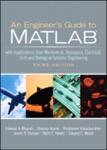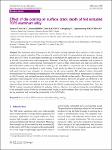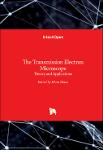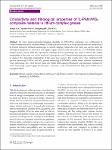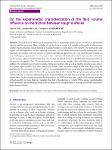Search
Author
- Amir, Ebrahimi (2)
- Aydin, Azizi (2)
- George, Haller (2)
- James, M. Fiore (2)
- next >
Subject
- robotics (9)
- Engineering (8)
- engineering (8)
- công nghệ (3)
- next >
Date issued
- 2020 - 2023 (215)
- 2010 - 2019 (28)
- 2001 - 2009 (6)
Has File(s)
- true (249)
Search Results
In Basic Engineering Data Collection and Analysis, Stephen B. Vardeman and J. Marcus Jobe stress the practical over the theoretical. Step by step, students get real engineering data and scenario examples along with chapter-long case studies that illustrate concepts in realistic, thoroughly detailed situations. This approach encourages students to work through the material by carrying out data collection and analysis projects from problem formulation through the preparation of professional technical reports—just as if they were on the job. |
Learn to light a candle in the darkest moments of someone’s life. Be the light that helps others see; it is what gives life its deepest significance. |
The aluminum alloys belonging to the 7000 series are high-strength alloys used in a wide variety of products for weight reduction. They are primarily used in the field of transportation and aerospace. Among these, the A7075 alloy has the highest strength and is expected to be applicable in a wide range of fields, such as aircraft components and sports equipment. However, it has high deformation resistance and is prone to surface defects, which is called tearing. Tearing typically occurs at high temperatures and high ram speeds, and adversely affects productivity. The localized melting of Zn and additive compounds, due to the heat generated during the process, is considered to cause tearing. In this study, the effect of friction, heat, and tearing at the tool—metal interface was miti... |
This book The Transmission Electron Microscope abundantly illustrates necessary insight and guidance of this powerful and versatile material characterization technique with complete figures and thorough explanations. The second edition of the book presents deep understanding of new techniques from introduction to advance levels, covering in-situ transmission electron microscopy, electron and focused ion beam microscopy, and biological diagnostic through TEM. The chapters cover all major aspects of transmission electron microscopy and their uses in material characterization with special emphasis on both the theoretical and experimental aspects of modern electron microscopy techniques. It is believed that this book will provide a solid foundation of electron microscopy to the students... |
This work shows that a soft, thin film comprising randomly aligned carbon nanotubes (CNTs) can reduce surface wear more effectively than a homogeneous thin film because of enhanced elastic recoverability and contact stress relief originating from its mesh structure. To investigate the wear characteristics of the mesh structure compared to those of the homogeneous thin film, multi-walled CNTs (MWCNTs) and diamond-like carbon (DLC) thin films were prepared to conduct nanoscale tribological experiments using the atomic force microscopy (AFM). The MWCNT thin film showed unmeasurably low wear compared with the DLC thin film under a certain range of normal load. To demonstrate the wear reduction mechanism of the MWCNT thin film, its indentation and frictional behaviors were assessed. |
Conductivity and tribological properties of IL-PANI/WS2 composite material in lithium complex grease An ionic liquid-polyaniline/tungsten disulfide (IL-PANI/WS2) composite was synthesized in 1-butyl-3-methylimidazole tetrafluoroborate (LB104) aqueous solution by in-situ polymerization and characterized by Fourier transform infrared spectroscopy. A current-carrying friction and wear tester was used to study the tribological properties of steel—steel and copper—copper friction pairs lubricated by an IL-PANI/WS2 lithium complex grease (LCG). After the experiment, scanning electron microscope was used to observe the surface morphology of the wear scar on the steel and copper plates, and X-ray photoelectron spectrometer was used to analyze the elemental composition of the wear scar surface. The results show that compared with greases containing IL-PANI and WS2, greases containing IL-PAN... |
Carbon nanoparticle coatings on laser-patterned stainless-steel surfaces present a solid lubrication system where the pattern’s recessions act as lubricant-retaining reservoirs. This study investigates the influence of the structural depth of line patterns coated with multi-walled carbon nanotubes (CNTs) and carbon onions (COs) on their respective potential to reduce friction and wear. Direct laser interference patterning (DLIP) with a pulse duration of 12 ps is used to create line patterns with three different structural depths at a periodicity of 3.5 µm on AISI 304 steel platelets. |
The dynamics of a spacecraft propelled by a continuous radial thrust resembles that of a nonlinear oscillator. This is analyzed in this work with a novel method that combines the definition of a suitable homotopy with a classical perturbation approach, in which the low thrust is assumed to be a perturbation of the nominal Keplerian motion. The homotopy perturbation method provides the analytical (approximate) solution of the dynamical equations in polar form to estimate the corresponding spacecraft propelled trajectory with a short computational time. The accuracy of the analytical results was tested in an orbital-targeting mission scenario. |
This book aims to narrate fundamental concepts of structural design to architecture students such that they have minimum involvement with math problem-solving. Within this book, students learn about different types of loads, forces and vector addition, the concept of equilibrium, internal forces, geometrical and material properties of structural elements, and rules of thumb for estimating the proportion of some structural systems such as catenary cables and arches, trusses, and frame structures. |
The load-bearing behaviour of lubricated contacts depends primarily on the normal force, the relative velocity, and the geometry. Thus, with the aid of the Stribeck curve, it is usually well possible to characterize whether hydrodynamics, mixed friction, or boundary friction is more likely to be present. The fact that the load regime can also depend on the fluid quantity is obvious, but has hardly been systematically investigated so far. Especially for contacts with microscopic roughness, the defined application of a very small amount of fluid is a very challenging requirement. In this paper, a very fundamental study shows how a pin-on-disc tribometer can be used to achieve the transition from dry friction via mixed friction to predominant hydrodynamics by the amount of supplied flu... |


